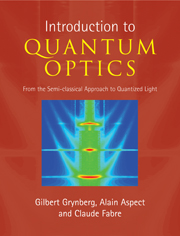Book contents
- Frontmatter
- Contents
- Foreword
- Preface
- Acknowledgements
- Part I Semi-classical description of matterlight interaction
- Part II Quantum description of light and its interaction with matter
- Part III Applying both approaches
- 7 Nonlinear optics. From the semi-classical approach to quantum effects
- Complement 7A: Parametric amplification and oscillation. Semi-classical and quantum properties
- Complement 7B: Nonlinear optics in optical Kerr media
- 8 Laser manipulation of atoms. From incoherent atom optics to atom lasers
- Complement 8A: Cooling to sub-recoil temperatures by velocity-selective coherent population trapping
- Index
Complement 7B: Nonlinear optics in optical Kerr media
Published online by Cambridge University Press: 05 August 2012
- Frontmatter
- Contents
- Foreword
- Preface
- Acknowledgements
- Part I Semi-classical description of matterlight interaction
- Part II Quantum description of light and its interaction with matter
- Part III Applying both approaches
- 7 Nonlinear optics. From the semi-classical approach to quantum effects
- Complement 7A: Parametric amplification and oscillation. Semi-classical and quantum properties
- Complement 7B: Nonlinear optics in optical Kerr media
- 8 Laser manipulation of atoms. From incoherent atom optics to atom lasers
- Complement 8A: Cooling to sub-recoil temperatures by velocity-selective coherent population trapping
- Index
Summary
In this complement we discuss several examples of optical phenomena in media where the refractive index depends nonlinearly on the intensity, known as optical Kerr media. This nonlinear effect exists in all materials, even isotropic ones, like glass or fused silica, but it is particularly marked in certain physical systems to be exemplified in Section 7B.1. After investigating the propagation of light through such media in Section 7B.2, we shall discuss three applications of the optical Kerr effect (which can be studied in any order). We begin by describing a bistable optical system, when this nonlinear medium is inserted in a Fabry–Perot cavity (Section 7B.3). We then study phase conjugate mirrors and examine their potential applications in adaptive optics (Section 7B.4). Finally, we discuss certain effects occurring during the propagation of an isolated wave, bounded either transversely or temporally, in a Kerr medium, and describe self-focusing effects (Section 7B.5) and self-phase-modulation effects (Section 7B.6). In particular, we shall show that nonlinear effects and dispersion effects can compensate to produce stable structures known as solitons, which maintain their shape during propagation.
Examples of third-order nonlinearities
Nonlinear response of two-level atoms
We begin by studying a simple case of a nonlinear interaction, namely a two-level quantum system under the effects of a plane wave.
- Type
- Chapter
- Information
- Introduction to Quantum OpticsFrom the Semi-classical Approach to Quantized Light, pp. 577 - 598Publisher: Cambridge University PressPrint publication year: 2010



